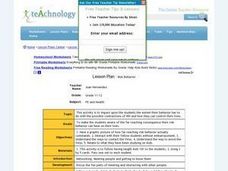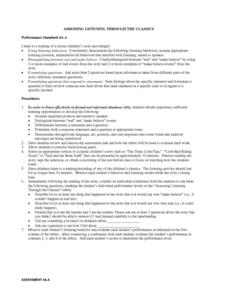Curated OER
Blue Cheese Breath and Stinky Feet: How To Deal With Bullies
Students explore human behavior by reading a children's story in class. In this bullying lesson, students read the story Blue Cheese Breath and Stinky Feet by Catherine Depino. Students answer study questions about the story and...
Curated OER
Instinct vs. Learned Behavior
Fifth graders engage in a discussion about learned vs. instinctive behaviors. They list of behaviors on the board with the help of Students. They go back through the list and use two symbols, one for instinctive and one for learned.
Curated OER
HIV/AIDS: Understanding Risk Behaviors
Eighth graders recongize the difference between HIV and AIDS. They explore how one finds out they have the disease and their treatment options. They discuss risky and safe behaviors when dealing with HIV or AIDS.
Curated OER
Physiology Activity Perception and Behavior
Students conduct an experiment to determine a fly's ability to detect sugar, its behavioral response, how a previous experience may alter the response, if a fly can be tricked, and how human sensitivity compares to a fly.
Curated OER
Investigating Human Behavior
Students explore the Holocaust and themes such as prejudice and discrimination.
Curated OER
Risk Behavior
Students explore information about HIV and how the possible contractions of the disease can control their lives. The Far reaching consequences of risk behavior are discussed.
Curated OER
Behavior Assessment & Nutrient Needs
Students identify the factors that influence eating behaviors. They discover the nutrients that are needed in a teenager's body. They also identify the major food groups and examine the food pyramid.
Curated OER
Behavior Reflection
In this behavior reflection worksheet, students fill out a form that states how their choice of behavior was for the day and why they had to move to "red" for the day.
Florida Department of Health
Nutrition: Developing Healthy Habits Unit
The focus of the fourth unit in the Youth Risk Behavior Survey Curriculum is on healthy eating and exercise. Class members examine healthy habits data from the YRBD Youth Online Tool, learn about the importance of a healthy diet and...
Autism Speaks
Tips for working with participants with Autism
Everyday life can be overwhelming for a student with autism spectrum disorder. An informative presentation guides teachers through definitions of common attributes associated with autism, as well as ways to meet sensory needs to...
All for KIDZ
Bulletin Board Kit: A Class of Champions
Encourage the all-star students in your class with a bulletin board idea that showcases them! "A Class of Champions" is a sure way to inspire class members to do their best, persevere, and encourage their peers.
Facebook
Online Presence
What happens when an online post gets the wrong kind of attention? Learners evaluate the good, the bad, and the occasionally ugly side of social media posting with a instructional activity from a vast digital citizenship series. After...
Federal Reserve Bank
Time Inconsistency: Today’s Actions = Tomorrow’s Regrets
Why do we choose instant gratification over maximizing lifetime satisfaction? How is this reflected in government and macroeconomics? Learn how one research analyst proposes individuals and governments can accomplish greater lifetime...
Balanced Assessment
Local and Global Behavior
Create rules for numerical sequences. Pupils develop local rules and recursive rules for number sequences. The sequences are linear, quadratic, and cubic in nature. Scholars find that some local rules do not work, no matter where in the...
Mathematics Vision Project
Module 6: Modeling Periodic Behavior
Around and around we go ... again, and again, and again, and again! That's the nature of a periodic function. Young scholars learn how to model a periodic pattern with trigonometric functions. The nine-lesson unit explores the connection...
Flipped Math
Calculus AB/BC - Exploring Behaviors of Implicit Relations
Put everything together implicitly. Pupils use their knowledge of implicit differentiation to determine whether a curve is increasing or decreasing or its concavity. Given a differential equation, scholars determine whether a specific...
NASA
Behavior Over Time: Analyzing Seasonal Soil and Air Properties
Moisture can affect air temperatures and so much more! An analysis of NASA soil moisture data allows pupils to make connections between climate and weather features. They first review general data and then select a specific location to...
Curated OER
Pets: Oh Behave
Students develop an understanding of how innate and learned behaviors and the environment determine behavior. They see how a variety of factors affects our pet's behavior-including species-specific traits, the environment, training, and...
Curated OER
What's All the Buzz About
Students participate in a game of charades to examine different animal behaviors. After reading an article, they discuss why bees waggle and how that behavior applies to humans. They research the behaviors of an animal of interest to...
Curated OER
More of, Less of
Have your class discuss behaviors they like from other people. They will then get into groups and list behaviors they want to see more of from people in their community, classroom, or school. This is a great Character Counts lesson!
Curated OER
Mammals: Mammals and Their Ways
Students study the difference between innate and learned behaviors. They observe the adaptations and behaviors of mammals in this series of lessons.
Curated OER
The American Prairie
Students design an animal. In this prairie activity, students learn about physical and behavioral adaptation, locate the Great Plains on a map, and design an animal that would be perfectly adapted for life on the prairie. Students...
Curated OER
Role of Cerci in Escape Responses of the Cockroach
Students investigate the changes in escape behavior in Madagascar Hissing Cockroahes when their sensory apparatus is removed. They use puffs of air at differnt angles to simulate a predator's approach then collect and analyze data on...
Curated OER
ASSESSING LISTENING THROUGH THE CLASSICS
Students demonstrate listening behaviors. They assume appropriate listening position, minimize/avoid behaviors that interfere with listening, and attend to speaker. They distinguish between real and make believe and cite 2 or more...
Other popular searches
- Animal Behavior
- Positive Behavior
- Behavioral Ecology
- Learned Behavior
- Behavior Charts and Graphs
- Ethical Workplace Behavior
- Behavior Management
- Behavioral Adaptations
- Innate Behavior
- Behavior in the Workplace
- Inappropriate Behavior
- Behavior Modification

























